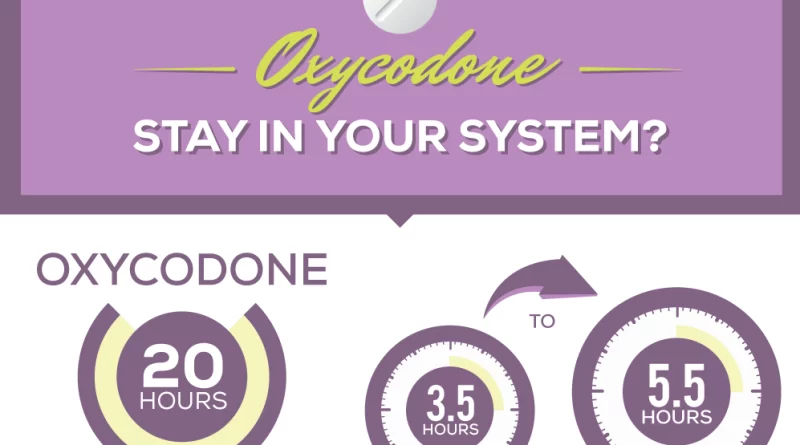When does Oxycodone leave your system
If you’ve recently been prescribed Oxycodone for pain relief, you might wonder how long it will remain in your system. Oxycodone, a potent opioid analgesic, is commonly prescribed for moderate to severe pain. While it effectively blocks pain signals in the brain, it’s essential to understand how long it stays in your system, as prolonged use can lead to addiction and physical dependence. When does Oxycodone leave your system? This article will provide comprehensive information about the duration of Oxycodone’s presence in your body.
Understanding How Oxycodone Works
Oxycodone is a powerful pain reliever binding to opioid receptors in the brain and spinal cord. This binding blocks pain signals and activates the brain’s reward center, creating pleasure and euphoria. However, its potency comes with a risk of addiction, making it essential to use only as prescribed by a healthcare provider.
How Long Is Oxycodone Detected in Drug Tests?
Various factors can influence how long Oxycodone remains detectable in your system. Different drug tests have varying detection windows:
Urine Testing
Urine drug monitoring is commonly used to detect opioids like Oxycodone. Typically, urine tests can detect Oxycodone in your system for two to four days after ingestion. However, the exact detection window may vary depending on metabolism and the amount consumed.
Blood Testing
Blood tests for Oxycodone are rapid and can detect the drug within 15 to 30 minutes of ingestion. Oxycodone remains detectable in your blood for up to 24 hours.
Saliva Testing
Saliva tests are convenient and can detect Oxycodone in your system for up to 48 hours after consumption. This method is often favored in clinical and academic settings due to the ease of sample collection.
Hair Follicle Testing
Hair follicle testing is the most effective method for detecting Oxycodone, with a detection window of up to 90 days after ingestion. However, urine testing is generally more effective at detecting recent Oxycodone use.
Factors Affecting Oxycodone’s Duration in Your System
Several factors can impact how long Oxycodone stays in your system. Individual variations in physiology make it impossible to pinpoint an exact duration. Here are some influential factors:
- Age: Older individuals may metabolize Oxycodone more slowly, resulting in a longer detection window.
- Weight: People with higher body mass indexes (BMI) might eliminate Oxycodone more slowly.
- Metabolism: Individuals with faster metabolisms may clear Oxycodone from their system more rapidly.
- Liver Function: The liver plays a vital role in Oxycodone metabolism. Liver disease or impairment can affect how quickly the drug is cleared.
- Kidney Function: Just like the liver, the kidneys metabolize medications. Renal impairment can prolong Oxycodone clearance.
Oxycodone False Positives and Interactions
While drug tests can detect Oxycodone, they aren’t foolproof and may yield false results. In some cases, other substances can cause a false positive for Oxycodone. These substances include quinolone antibiotics, poppy seeds, and rifampin. However, false positives are extremely rare, occurring in less than 1% of cases.
If you believe you have falsely tested positive for Oxycodone, it’s advisable to request additional testing to confirm the results.
How Long Does Oxycodone Last?
The duration of Oxycodone’s effects on your body depends on the method of ingestion:
- Injection: Injecting Oxycodone can lead to rapid onset of effects but poses significant risks, including overdose.
- Intranasal Ingestion: Snorting Oxycodone powder accelerates the release of the drug, causing effects within minutes.
- Swallowing Capsules or Tablets: Immediate-release Oxycodone typically provides pain relief for three to six hours, while controlled-release formulations can last around 12 hours.
It’s essential to follow your healthcare provider’s instructions and only take Oxycodone as prescribed. Injecting or snorting Oxycodone bypasses its controlled release mechanisms, potentially leading to overdose and severe health consequences.
Short-Term Effects of Oxycodone
Short-term use of Oxycodone can result in various side effects, including:
- Constipation
- Diarrhea or abdominal pain
- Dizziness
- Dry mouth
- Heart palpitations
- Nausea
- Sweating
- Vomiting
- Photosensitivity
Immediate-release Oxycodone provides pain relief for three to six hours, while controlled-release formulations can extend pain relief for approximately 12 hours.
Signs of an Oxycodone Addiction
If you’re concerned about how long Oxycodone will stay in your system or the possibility of a drug test, it’s crucial to recognize the signs of a potential substance use disorder. These signs may include:
- Taking larger doses or using the medication for longer than prescribed.
- Neglecting responsibilities, such as work, family, or social obligations, due to Oxycodone use.
- Developing tolerance, requiring higher doses for the same effect.
- Unsuccessful attempts to reduce or stop Oxycodone use.
If you or someone you know exhibits these signs, seeking help from a healthcare provider or addiction specialist is essential.
Factors That Affect Oxycodone Clearance
Several factors can affect how long Oxycodone remains in your system:
- Age: Oxycodone levels in blood plasma can be 15% higher in older individuals.
- Drug Interactions: Certain medications, like cardiovascular drugs and polycyclic antidepressants, can influence Oxycodone metabolism. Consult your healthcare provider to avoid harmful drug interactions.
- Gender: Women tend to have higher blood plasma concentrations of Oxycodone than men, regardless of body weight.
- Liver Impairment: Liver function is crucial in processing and clearing medications. Hepatic impairment can lead to slower Oxycodone clearance and higher blood concentrations.
- Kidney Impairment: Kidney function also affects Oxycodone clearance. Individuals with renal impairment may clear the drug more slowly, with a longer elimination half-life.
Summary
Oxycodone is a potent pain reliever prescribed for moderate to severe pain. Despite its effectiveness, it should only be used as directed by a healthcare provider due to its potential for abuse and addiction. If you’re concerned about how long Oxycodone will remain in your system, remember that it can be detected in urine for up to three days, in blood for up to 24 hours, and saliva for up to four days after use. In hair follicles, it can be detected for up to 90 days after the last use. However, age, weight, metabolism, and liver and kidney function can impact Oxycodone’s presence in your body.
Always follow your healthcare provider’s instructions meticulously when taking Oxycodone, and promptly report any side effects or concerns. If you suspect a substance use disorder or addiction, seek help from a qualified healthcare provider or addiction specialist. Your well-being is of utmost importance, and proper usage of Oxycodone is crucial for safe and effective pain management.
Frequently Asked Questions (FAQs)
1. How long does Oxycodone stay in your system?
Oxycodone can be detected in drug tests for varying durations, depending on factors such as the type of test and individual factors. In general, it can be seen in urine for about two to four days, in blood for up to 24 hours, and in saliva for approximately 48 hours after use. Hair follicle testing can detect Oxycodone for up to 90 days after the last use.
2. What factors affect how long Oxycodone stays in your system?
Several factors influence Oxycodone’s duration in your system, including age, weight, metabolism, liver, and kidney function. Older individuals and those with impaired liver or kidney function may metabolize Oxycodone more slowly, leading to a longer detection window.
3. Can Oxycodone appear in a drug test as a false positive?
While drug tests for Oxycodone are generally accurate, there have been rare false positives. Substances like quinolone antibiotics, poppy seeds, and rifampin can potentially cause false positive results for Oxycodone. If you suspect a false positive, request additional testing for confirmation.
4. What are the short-term effects of Oxycodone?
Short-term use of Oxycodone can lead to side effects such as constipation, diarrhea, dizziness, dry mouth, heart palpitations, nausea, sweating, and vomiting. These effects can vary in intensity and may impact individuals differently.
5. How long do the pain-relieving effects of Oxycodone last?
The duration of pain relief provided by Oxycodone depends on the formulation. Immediate-release Oxycodone typically offers relief for three to six hours, while controlled-release versions can provide pain relief for approximately 12 hours.
6. What are the signs of an Oxycodone addiction?
Signs of an Oxycodone addiction may include taking larger doses than prescribed, using the medication for longer than directed, neglecting responsibilities due to drug use, developing tolerance, and unsuccessful attempts to reduce or stop Oxycodone use. If you or someone you know exhibits these signs, seek professional help.
7. Can Oxycodone be used safely for pain management?
Oxycodone can be used safely for pain management when prescribed and taken as directed by a healthcare provider. Communicating openly with your healthcare provider about any concerns or side effects is crucial. Misuse or abuse of Oxycodone can lead to addiction and severe health risks.
8. How can I help someone struggling with Oxycodone addiction?
If you suspect someone you know is struggling with an Oxycodone addiction, encourage them to seek professional help. Offer your support and understanding, and avoid judgment. Addiction is a medical condition that requires treatment and support.
9. Are there alternative pain management options to Oxycodone?
Yes, there are alternative pain management options available. Your healthcare provider can explore non-opioid pain medications, physical therapy, acupuncture, and other treatments based on your specific needs and the nature of your pain.
10. Is it safe to stop taking Oxycodone suddenly?
Abruptly stopping Oxycodone can lead to withdrawal symptoms, which can be uncomfortable and challenging to manage. It’s essential to work closely with your healthcare provider to gradually reduce your Oxycodone dosage if you no longer require the medication. This approach helps minimize withdrawal symptoms and ensures your safety during the process.




